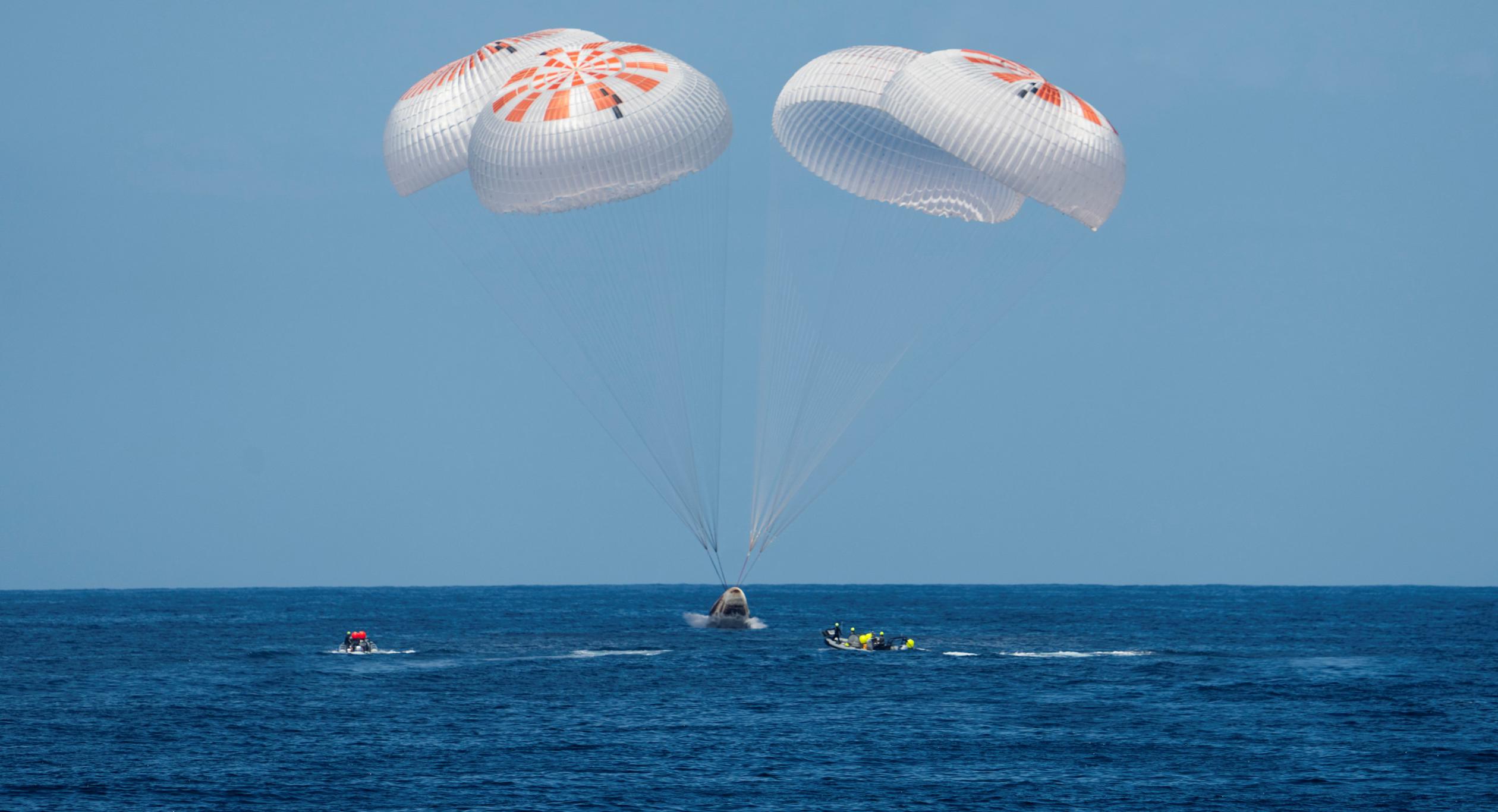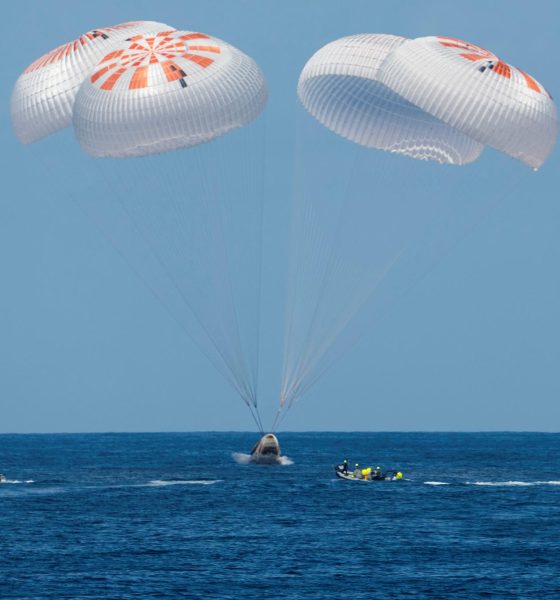

News
SpaceX Dragon returns private astronauts to Earth after an extra week in space
Update: A SpaceX Crew Dragon has finally returned Axiom Space’s first crew of four private astronauts to Earth after recovery delays ultimately gave the passengers and extra six days in space, boosting their total trip duration from 10-12 days to 17 days.
In the process, capsule C206 (Endeavour) became the first Crew Dragon to successfully transport astronauts to the International Space Station and back to Earth three times. SpaceX and NASA have already certified each Crew Dragon capsule for five flights – a number that will likely need to expanded within just a year or two. SpaceX is currently scheduled to launch Crew-4 no earlier than (NET) April 27th, Axiom-2 NET Q3 2022, Crew-5 NET October 2022, and Polaris Dawn NET late 2022.
Following extensive weather delays, a SpaceX Crew Dragon spacecraft has undocked from the International Space Station (ISS) after carrying the first all-private astronaut mission to the orbital outpost.
That private mission – known as Axiom-1 – was originally supposed to head to the ISS in February and, later, late March. For unspecified reasons, apparent issues with processing or Dragon/Falcon refurbishment ultimately pushed Ax-1’s launch to April 8th. Initially, the crew of four astronauts – one former NASA astronaut turned Axiom pilot and three wealthy paying customers – were scheduled to spend around ten days in space and eight days aboard the ISS. At some point before liftoff, that was updated to 12 days in space and 10 days aboard the station.
Shortly before liftoff, NASA’s official schedule had Axiom-1’s undocking and space station departure penciled in for April 19th. On April 19th, NASA, SpaceX, and Axiom decided to waive off the first departure attempt due to weather issues that were apparently impacting all seven of Crew Dragon’s nominal recovery zones – four in the Gulf of Mexico and three in the Atlantic Ocean. On April 20th, the next undocking attempt was pushed to no earlier than April 23rd. On April 23rd, the teams yet again called off the departure.
Finally, at 9:10 pm EDT on April 24th, the heavens apparently aligned and the Axiom-1 crew was able to board Crew Dragon, undock from the ISS, and begin their ~15-hour trip back to Earth. Until splashdown (NET 1pm EDT, April 25th), however, SpaceX and NASA will still be unable to settle with any confidence on a firm launch date for their Crew-4 NASA and ESA astronaut transport mission. Originally scheduled for April 15th, Axiom-1’s delays have pushed the Crew-4 launch to no earlier than (NET) 3:52 am EDT (07:52 UTC) on April 27th – nearly two weeks behind schedule.
Thankfully, that should be no problem for the ISS or Crew-3. Crew Dragon is currently certified to spend up to 210 days in orbit, and NASA had already planned for Crew-3 to return before even the usual six-month stint aboard the space station, so Crew-4 could have slipped well into early June 2022 without much of a problem. Nonetheless, NASA still plans to inspect the Axiom-1 Crew Dragon and analyze all data gathered from the mission to ensure nothing was amiss before giving SpaceX the green light to launch Crew-4.
Due to the current proximity of Axiom-1’s splashdown and Crew-4’s launch, even a minor delay or issue during the post-flight review would likely push Crew-4 to April 28th. With any luck, though, Axiom-1’s recovery and data review will be close to perfect and allow Crew-4 to finally get off the ground on the 27th.
Simultaneously, SpaceX is preparing to launch another batch of Starlink satellites as early as April 29th. If both missions avoid delays, Starlink 4-16 will be the company’s sixth launch in April and 17th launch this year.

News
Tesla FSD V14.2.1 is earning rave reviews from users in diverse conditions
Tesla’s Full Self-Driving (Supervised) software continues its rapid evolution, with the latest V14.2.1 update drawing widespread praise.

Tesla’s Full Self-Driving (Supervised) software continues its rapid evolution, with the latest V14.2.1 update drawing widespread praise for its smoother performance and smarter decision-making.
Videos and firsthand accounts from Tesla owners highlight V14.2.1 as an update that improves navigation responsiveness, sign recognition, and overall fluidity, among other things. Some drivers have even described it as “more alive than ever,” hinting at the system eventually feeling “sentient,” as Elon Musk has predicted.
FSD V14.2.1 first impressions
Early adopters are buzzing about how V14.2.1 feels less intrusive while staying vigilant. In a post shared on X, Tesla owner @LactoseLunatic described the update as a “huge leap forward,” adding that the system remains “incredibly assertive but still safe.”
Another Tesla driver, Devin Olsenn, who logged ~600 km on V14.2.1, reported no safety disengagements, with the car feeling “more alive than ever.” The Tesla owner noted that his wife now defaults to using FSD V14, as the system is already very smooth and refined.
Adverse weather and regulatory zones are testing grounds where V14.2.1 shines, at least according to testers in snow areas. Tesla watcher Sawyer Merritt shared a video of his first snowy drive on unplowed rural roads in New Hampshire, where FSD did great and erred on the side of caution. As per Merritt, FSD V14.2.1 was “extra cautious” but it performed well overall.
Sign recognition and freeway prowess
Sign recognition also seemed to show improvements with FSD V14.2.1. Longtime FSD tester Chuck Cook highlighted a clip from his upcoming first-impressions video, showcasing improved school zone behavior. “I think it read the signs better,” he observed, though in standard mode, it didn’t fully drop to 15 mph within the short timeframe. This nuance points to V14.2.1’s growing awareness of temporal rules, a step toward fewer false positives in dynamic environments.
FSD V14.2.1 also seems to excel in high-stress highway scenarios. Fellow FSD tester @BLKMDL3 posted a video of FSD V14.2.1 managing a multi-lane freeway closure due to a police chase-related accident. “Perfectly handles all lanes of the freeway merging into one,” the Tesla owner noted in his post on X.
FSD V14.2.1 was released on Thanksgiving, much to the pleasant surprise of Tesla owners. The update’s release notes are almost identical to the system’s previous iteration, save for one line item read, “Camera visibility can lead to increased attention monitoring sensitivity.”
News
Tesla FSD Supervised ride-alongs in Europe begin in Italy, France, and Germany
The program allows the public to hop in as a non-driving observer to witness FSD navigate urban streets firsthand.

Tesla has kicked off passenger ride-alongs for Full Self-Driving (Supervised) in Italy, France and Germany. The program allows the public to hop in as a non-driving observer to witness FSD navigate urban streets firsthand.
The program, detailed on Tesla’s event pages, arrives ahead of a potential early 2026 Dutch regulatory approval that could unlock a potential EU-wide rollout for FSD.
Hands-Off Demos
Tesla’s ride-along invites participants to “ride along in the passenger seat to experience how it handles real-world traffic & the most stressful parts of daily driving, making the roads safer for all,” as per the company’s announcement on X through its official Tesla Europe & Middle East account.
Sign-ups via localized pages offer free slots through December, with Tesla teams piloting vehicles through city streets, roundabouts and highways.
“Be one of the first to experience Full Self-Driving (Supervised) from the passenger seat. Our team will take you along as a passenger and show you how Full Self-Driving (Supervised) works under real-world road conditions,” Tesla wrote. “Discover how it reacts to live traffic and masters the most stressful parts of driving to make the roads safer for you and others. Come join us to learn how we are moving closer to a fully autonomous future.”
Building trust towards an FSD Unsupervised rollout
Tesla’s FSD (Supervised) ride-alongs could be an effective tool to build trust and get regular car buyers and commuters used to the idea of vehicles driving themselves. By seating riders shotgun, Tesla could provide participants with a front row seat to the bleeding edge of consumer-grade driverless systems.
FSD (Supervised) has already been rolled out to several countries, such as the United States, Canada, Australia, New Zealand, and partially in China. So far, FSD (Supervised) has been received positively by drivers, as it really makes driving tasks and long trips significantly easier and more pleasant.
FSD is a key safety feature as well, which became all too evident when a Tesla driving on FSD was hit by what seemed to be a meteorite in Australia. The vehicle moved safely despite the impact, though the same would likely not be true had the car been driven manually.
News
Swedish union rep pissed that Tesla is working around a postal blockade they started
Tesla Sweden is now using dozens of private residences as a way to obtain license plates for its vehicles.

Two years into their postal blockade, Swedish unions are outraged that Tesla is still able to provide its customers’ vehicles with valid plates through various clever workarounds.
Seko chairman Gabriella Lavecchia called it “embarrassing” that the world’s largest EV maker, owned by CEO Elon Musk, refuses to simply roll over and accept the unions’ demands.
Unions shocked Tesla won’t just roll over and surrender
The postal unions’ blockade began in November 2023 when Seko and IF Metall-linked unions stopped all mail to Tesla sites to force a collective agreement. License plates for Tesla vehicles instantly became the perfect pressure point, as noted in a Dagens Arbete report.
Tesla responded by implementing initiatives to work around the blockades. A recent investigation from Arbetet revealed that Tesla Sweden is now using dozens of private residences, including one employee’s parents’ house in Trångsund and a customer-relations staffer’s home in Vårby, as a way to obtain license plates for its vehicles.
Seko chairman Gabriella Lavecchia is not pleased that Tesla Sweden is working around the unions’ efforts yet again. “It is embarrassing that one of the world’s largest car companies, owned by one of the world’s richest people, has sunk this low,” she told the outlet. “Unfortunately, it is completely frivolous that such a large company conducts business in this way.”
Two years on and plates are still being received
The Swedish Transport Agency has confirmed Tesla is still using several different workarounds to overcome the unions’ blockades.
As noted by DA, Tesla Sweden previously used different addresses to receive its license plates. At one point, the electric vehicle maker used addresses for car care shops. Tesla Sweden reportedly used this strategy in Östermalm in Stockholm, as well as in Norrköping and Gothenburg.
Another strategy that Tesla Sweden reportedly implemented involved replacement plates being ordered by private individuals when vehicles change hands from Tesla to car buyers. There have also been cases where the police have reportedly issued temporary plates to Tesla vehicles.









